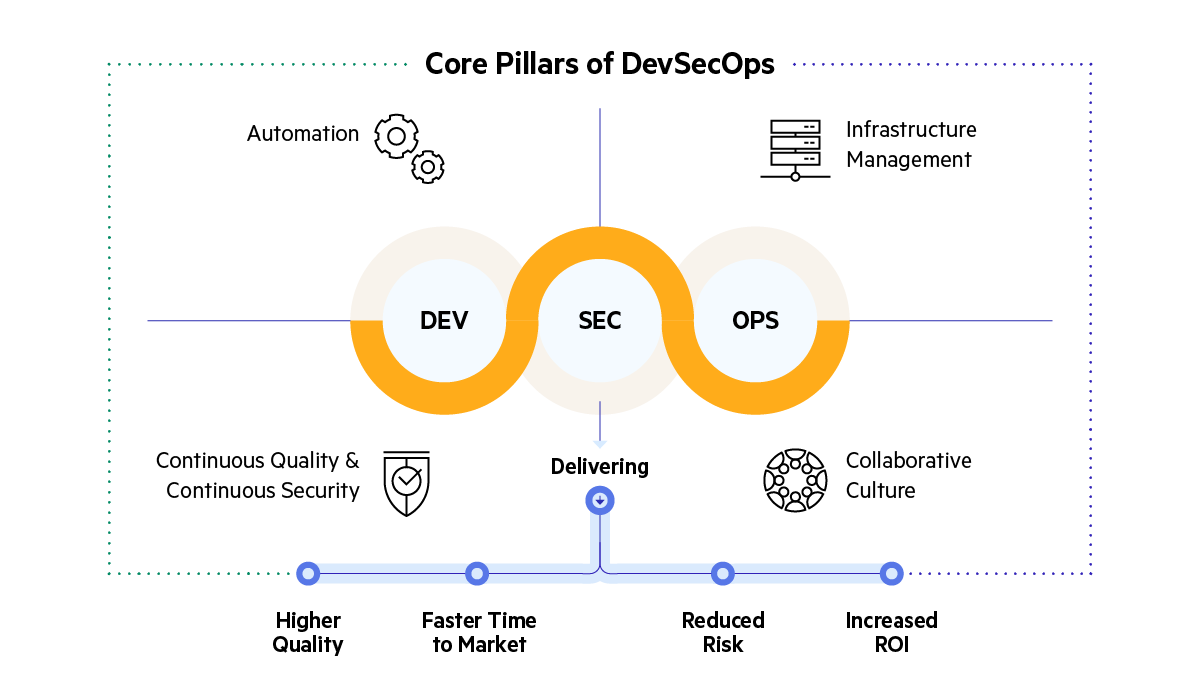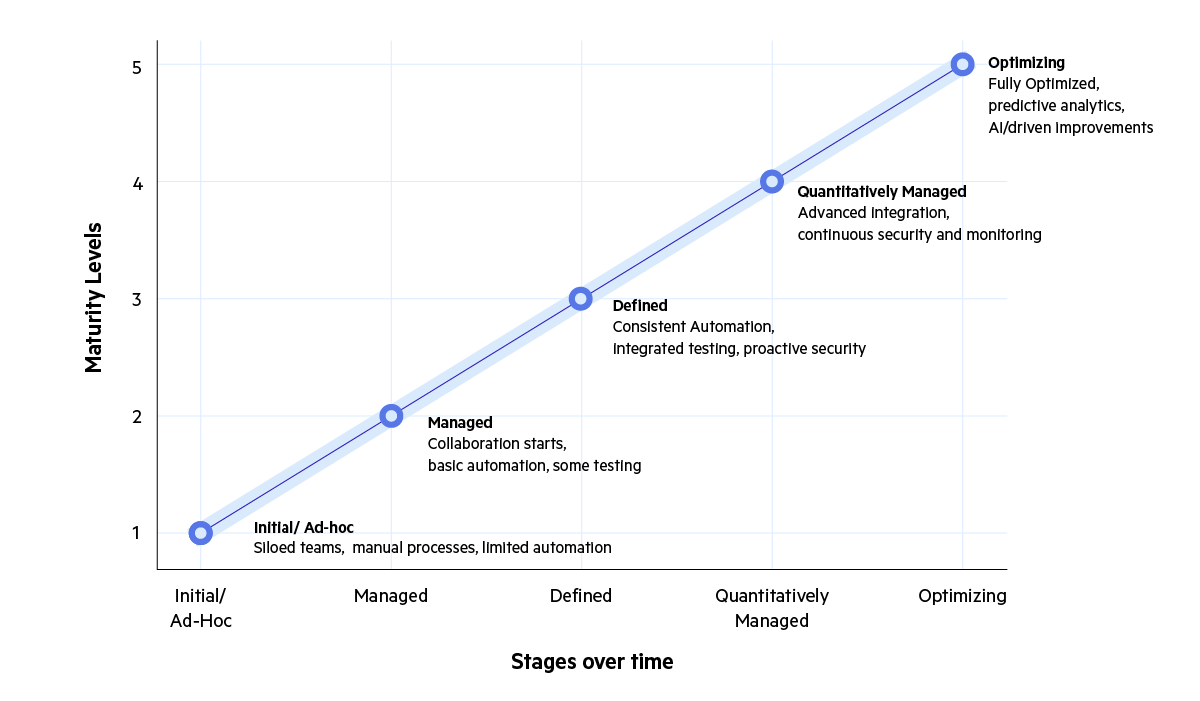As organizations progress in their DevSecOps journey, the focus shifts from implementing security into workflows to help optimize and continuously improve processes. After laying the groundwork - such as integrating security testing early in development and enabling collaboration between teams - the next challenge is pushing these practices to their full potential.
The earlier blog emphasized the importance of integrating security into the development lifecycle, particularly the need for automation and real-time monitoring. Now, let’s focus on how organizations can elevate these principles and achieve higher maturity levels.

Building on Established Foundations
In the early stages, organizations began by incorporating security into their CI/CD pipelines, automating key processes and facilitating greater collaboration between teams. However, to truly advance, organizations must take these efforts further by moving from integration to optimization.
The Chef Maturity Assessment is a pivotal tool in this stage. It's not just about confirming that practices are in place—it's about identifying how well those practices are implemented and uncovering areas for growth. For example, organizations with basic processes can use the assessment to explore advanced automation, such as AI-driven threat detection, which anticipates security risks in real time.
Key Areas of Focus on for Advancement
While foundational elements like security testing, automation and team collaboration have been addressed, advancing DevSecOps maturity involves pushing these areas into more intelligent, data-driven workflows. Here’s how to take it further:
Refining Automation
Automation is essential, but higher maturity levels demand smarter, predictive automation. Instead of only automating security tests and code integration, organizations can use AI to predict bottlenecks and vulnerabilities before they happen. This predictive capability allows for faster decision-making and better risk mitigation.Proactive Monitoring
As mentioned in the previous blog, monitoring continuously tracks performance and security metrics for your organization. However, advanced organizations take this a step further by using proactive monitoring to prevent incidents before they occur. This is key to reducing downtime and maintaining seamless operations during peak periods.Cross-Functional Team Alignment
Initially, the focus was on breaking silos between development, security and operations teams. The next step is fostering deep integration where security becomes everyone's priority. This means embedding security practices into the everyday operations of every team, from code commits to deployment.
Elevating Collaboration: Moving Beyond Silos![]()
In earlier stages, the priority was to break down silos between teams, maintaining collaboration across development, security and operations. The challenge is taking that collaboration deeper - moving beyond basic teamwork to a fully integrated culture. Security needs to become part of the DNA of every workflow, not just something to check off at the end.

Continuous integration was a critical element covered previously, where the need for smooth collaboration between teams helped reduce last-minute deployment hurdles. Now, organizations need to embed security into each step of the development lifecycle, making it seamless and instinctive.
The Role of the Chef Maturity Assessment
The Chef Maturity Assessment is a key tool for evaluating how well these deeper integrations are taking place. It provides a roadmap identifying whether security practices are truly ingrained in an organization's culture. For example, a fintech company that had already automated much of its security testing used the assessment to identify further gaps in how well these automated processes aligned with real-time threat responses.
By using the assessment to evaluate practices, teams can stay ahead of potential risks rather than just responding to them.
Transitioning From Reactive to Proactive Monitoring
While real-time monitoring was initially introduced to catch issues as they occur, the next level of DevSecOps maturity involves proactive monitoring. In this stage, organizations don’t just react to threats—they anticipate them.
This proactive approach leverages data from real-time monitoring tools to identify patterns and predict possible disruptions before they happen. It aligns with the shift-left methodology mentioned previously, where security becomes an integral part of the development process early on.
Automation that Adapts and Learns
Basic automation, such as automating code integration and security scans, was a significant milestone for organizations starting this journey. Now, the goal is to make automation smarter and more adaptive. Automation should streamline repetitive tasks and analyze the output, learn from it and optimize itself over time.
A key aspect of the earlier blog was deploying and maintaining automation solutions. Building on that idea, advanced automation solutions now incorporate machine learning to adjust security settings or optimize performance based on historical data, making the system more efficient and secure.
Embedding Security Into Organizational Culture
As organizations mature, security evolves from an isolated task to an integral part of the development process. Misconfigurations, often introduced inadvertently, can lead to significant vulnerabilities if not addressed promptly. Forrester highlights that misconfigurations due to complexity and ineffective security controls will lead to more data compromises as more workloads move to the cloud.
By embedding security into every phase - from initial design to final rollout - teams can proactively address these potential risks. This deep integration fosters a culture where security is a shared responsibility, reducing the likelihood of missteps, enhancing collaboration and improving time-to-market outcomes.
Continuous Innovation Through DevSecOps
The journey toward full DevSecOps maturity is continuous and the Chef Maturity Assessment helps organizations stay on track. As described in the previous blog, security testing, automation and collaboration principles were essential for setting a foundation. Now, the focus shifts toward innovation—finding smarter, more efficient ways to secure, monitor and enhance workflows.
As organizations mature, their development pipelines are secured, opening the door to faster, more reliable releases.

The journey toward a mature DevSecOps environment is ongoing. The Chef Maturity Assessment helps organizations assess their current standing and charts a strategic path for continuous improvement. As DevSecOps practices become more deeply integrated into your workflows, you'll unlock the full potential of efficient, more secure software delivery. Take the next step in optimizing your DevSecOps practices!
Download our whitepaper on the Chef Maturity Assessment
Explore how this assessment can guide your organization to the next level of DevSecOps maturity.

